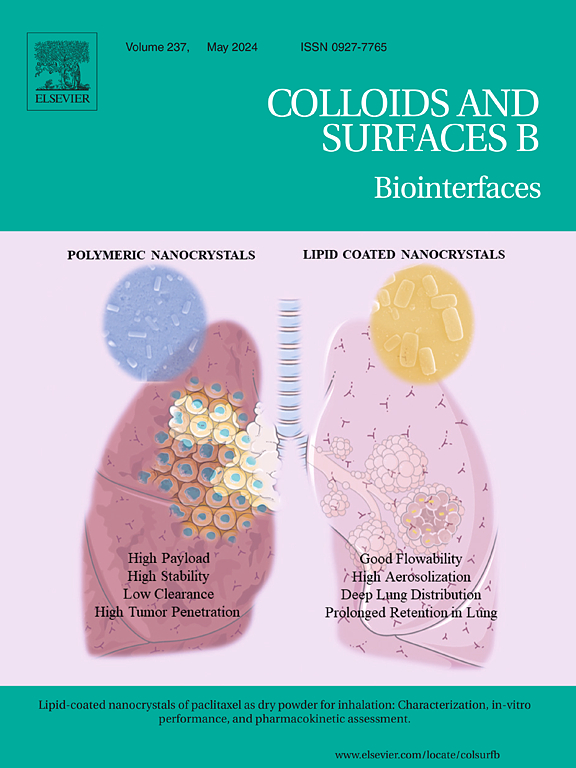Ultrasound-responsive MoS2@pCu-MOF heterojunction scaffold: Enhancing bacterial membrane permeability, exhibiting efficient antibacterial activity and facilitating bone regeneration
IF 5.4
2区 医学
Q1 BIOPHYSICS
引用次数: 0
Abstract
Phosphate-based Cu-MOF (pCu-MOF), a bioactive material with copper ions as framework centers and phosphate as the skeleton, shows chemodynamic antibacterial properties and bone regeneration potential via PO₄³ ⁻ release. However, its chemodynamic therapy (CDT) relies too much on cellular microenvironment's hydrogen peroxide (H₂O₂) level, and low-concentration reactive oxygen species (ROS) can't penetrate the bacterial membrane well, limiting antibacterial efficiency. To solve this, we created MoS₂@pCu-MOF type-II heterojunction nanocomposites to boost bacterial membrane permeability, effectively eliminating bacteria and promoting bone regeneration. Sonodynamic therapy (SDT) increases membrane permeability, allowing ROS to penetrate and disrupt bacteria. The type-II heterojunction, with SDT ability, generates hydroxyl radicals (·OH) and singlet oxygen (¹O₂) independently of H₂O₂ level by promoting electron-hole pair separation, achieving high antibacterial activity. Also, heterojunction-induced microcurrents under SDT synergize with PO₄³ ⁻ to stimulate osteogenesis. We incorporated MoS₂@pCu-MOF nanocomposites into a poly-l-lactic acid (PLLA) scaffold via selective laser sintering. Under ultrasonic stimulation, bacterial membrane permeability increases. Separated charge carriers bind to active sites of the MoS₂@pCu-MOF heterojunction scaffold to generate ·OH and ¹O₂, enabling high antibacterial efficiency without relying on CDT. Electrochemical experiments showed improved electron-hole separation efficiency of the heterojunction scaffold. PO₄³ ⁻ release and ultrasound-induced microcurrents promoted bone regeneration. Results indicated that the inhibition rates of Staphylococcus aureus (S.aureus) and Escherichia coli (E.coli) reached 99 % and 98.5 %, respectively. Notably, ultrasound-induced microcurrents enhanced the scaffold's osteogenic capacity by 36 % at the late osteogenesis stage on the basis of ion stimulation and facilitated the expression of osteogenic factors like Runx-2, Wnt-10b, and BMP-2. These findings suggest MoS₂@pCu-MOF heterojunction scaffolds can achieve effective SDT/CDT dual-mode antibacterial activity and promote bone regeneration via ionic/sonoelectric dual-mode.
超声响应MoS2@pCu-MOF异质结支架:增强细菌膜的渗透性,表现出有效的抗菌活性,促进骨再生
磷酸基Cu-MOF (Cu-MOF)是一种以铜离子为骨架,磷酸盐为骨架的生物活性材料,通过PO₄³ ⁻释放,显示出化学动力学抗菌性能和骨再生潜力。但其化学动力治疗(CDT)过于依赖于细胞微环境的过氧化氢(H₂O₂)水平,低浓度活性氧(ROS)不能很好地穿透细菌膜,限制了抗菌效果。为了解决这个问题,我们创造了MoS 2 @ cu - mof ii型异质结纳米复合材料,以提高细菌膜的通透性,有效地消除细菌并促进骨再生。声动力疗法(SDT)增加膜的渗透性,使活性氧渗透和破坏细菌。ii型异质结具有SDT能力,通过促进电子-空穴对分离,独立于H₂O₂水平产生羟基自由基(·OH)和单线态氧(¹O₂),具有较高的抗菌活性。此外,在SDT下,异质结诱导的微电流与PO₄³ 协同作用,促进骨生成。我们通过选择性激光烧结将MoS 2 @pCu-MOF纳米复合材料掺入聚乳酸(PLLA)支架中。在超声刺激下,细菌膜的通透性增加。分离的电荷载流子结合到MoS₂@ cu - mof异质结支架的活性位点上生成·OH和¹O₂,无需依赖CDT即可实现高抗菌效率。电化学实验表明,该异质结支架的电子空穴分离效率有所提高。PO₄³ -释放和超声诱导的微电流促进骨再生。结果表明,对金黄色葡萄球菌(S.aureus)和大肠杆菌(E.coli)的抑制率分别为99 %和98.5 %。值得注意的是,超声诱导微电流在离子刺激的基础上,使支架成骨后期的成骨能力提高了36% %,促进了Runx-2、Wnt-10b、BMP-2等成骨因子的表达。这些结果表明,MoS 2 @pCu-MOF异质结支架可以实现有效的SDT/CDT双模抗菌活性,并通过离子/声电双模促进骨再生。
本文章由计算机程序翻译,如有差异,请以英文原文为准。
求助全文
约1分钟内获得全文
求助全文
来源期刊

Colloids and Surfaces B: Biointerfaces
生物-材料科学:生物材料
CiteScore
11.10
自引率
3.40%
发文量
730
审稿时长
42 days
期刊介绍:
Colloids and Surfaces B: Biointerfaces is an international journal devoted to fundamental and applied research on colloid and interfacial phenomena in relation to systems of biological origin, having particular relevance to the medical, pharmaceutical, biotechnological, food and cosmetic fields.
Submissions that: (1) deal solely with biological phenomena and do not describe the physico-chemical or colloid-chemical background and/or mechanism of the phenomena, and (2) deal solely with colloid/interfacial phenomena and do not have appropriate biological content or relevance, are outside the scope of the journal and will not be considered for publication.
The journal publishes regular research papers, reviews, short communications and invited perspective articles, called BioInterface Perspectives. The BioInterface Perspective provide researchers the opportunity to review their own work, as well as provide insight into the work of others that inspired and influenced the author. Regular articles should have a maximum total length of 6,000 words. In addition, a (combined) maximum of 8 normal-sized figures and/or tables is allowed (so for instance 3 tables and 5 figures). For multiple-panel figures each set of two panels equates to one figure. Short communications should not exceed half of the above. It is required to give on the article cover page a short statistical summary of the article listing the total number of words and tables/figures.
 求助内容:
求助内容: 应助结果提醒方式:
应助结果提醒方式:


